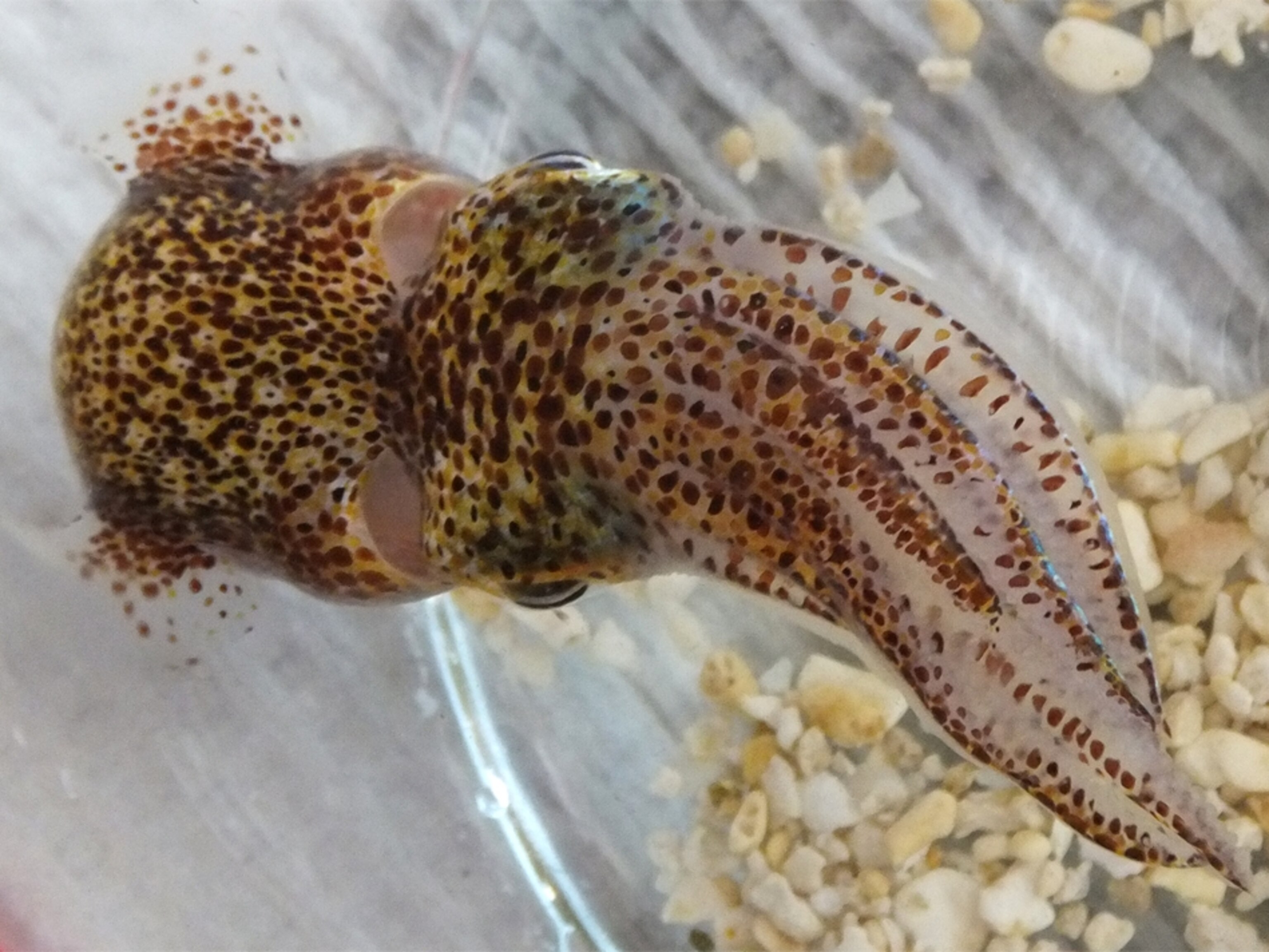It was a delight to profile the wonderful Margaret McFall-Ngai for Nature. She has done some great work on partnerships between a squid and its luminous bacterium, and she’s a powerful force in the world of animal-microbe partnerships. She’s also much-loved in the field; I have never had so many sources practically falling over themselves to sing someone’s praises. McFall-Ngai’s work will feature in my upcoming book, so consider this a little taster.
The aquarium looks empty, but there is something in it. A pair of eyes stick out from the sandy floor, and their owner is easily scooped up into a glass bowl. At first, the creature looks like a hazelnut truffle — small, round and covered in tiny flecks. But with a gentle shake, the flecks of sand fall off to reveal a female Hawaiian bobtail squid (Euprymna scolopes), about the size of a thumb. As she jets furiously around the bowl, discs of pigment bloom and fade over her skin like a living pointillist painting.
There are no other animals in the bowl, but the squid is not alone. Its undersides contain a two-chambered light organ that is full of glowing bacteria called Vibrio fischeri. In the wild, their luminescence is thought to match the moonlight welling down from above and cancel out the squid’s shadow, hiding the animal from predators. From below, the squid is invisible. From above, it is adorable. “They’re just so beautiful,” says Margaret McFall-Ngai, a zoologist at the University of Wisconsin–Madison. “They’re phenomenal lab animals.”
Related Topics
Go Further
Animals
- Octopuses have a lot of secrets. Can you guess 8 of them?
- Animals
- Feature
Octopuses have a lot of secrets. Can you guess 8 of them? - This biologist and her rescue dog help protect bears in the AndesThis biologist and her rescue dog help protect bears in the Andes
- An octopus invited this writer into her tank—and her secret worldAn octopus invited this writer into her tank—and her secret world
- Peace-loving bonobos are more aggressive than we thoughtPeace-loving bonobos are more aggressive than we thought
Environment
- Listen to 30 years of climate change transformed into haunting musicListen to 30 years of climate change transformed into haunting music
- This ancient society tried to stop El Niño—with child sacrificeThis ancient society tried to stop El Niño—with child sacrifice
- U.S. plans to clean its drinking water. What does that mean?U.S. plans to clean its drinking water. What does that mean?
- Food systems: supporting the triangle of food security, Video Story
- Paid Content
Food systems: supporting the triangle of food security - Will we ever solve the mystery of the Mima mounds?Will we ever solve the mystery of the Mima mounds?
History & Culture
- Strange clues in a Maya temple reveal a fiery political dramaStrange clues in a Maya temple reveal a fiery political drama
- How technology is revealing secrets in these ancient scrollsHow technology is revealing secrets in these ancient scrolls
- Pilgrimages aren’t just spiritual anymore. They’re a workout.Pilgrimages aren’t just spiritual anymore. They’re a workout.
- This ancient society tried to stop El Niño—with child sacrificeThis ancient society tried to stop El Niño—with child sacrifice
- This ancient cure was just revived in a lab. Does it work?This ancient cure was just revived in a lab. Does it work?
Science
- The unexpected health benefits of Ozempic and MounjaroThe unexpected health benefits of Ozempic and Mounjaro
- Do you have an inner monologue? Here’s what it reveals about you.Do you have an inner monologue? Here’s what it reveals about you.
- Jupiter’s volcanic moon Io has been erupting for billions of yearsJupiter’s volcanic moon Io has been erupting for billions of years
- This 80-foot-long sea monster was the killer whale of its timeThis 80-foot-long sea monster was the killer whale of its time
Travel
- How to plan an epic summer trip to a national parkHow to plan an epic summer trip to a national park
- This town is the Alps' first European Capital of CultureThis town is the Alps' first European Capital of Culture
- This royal city lies in the shadow of Kuala LumpurThis royal city lies in the shadow of Kuala Lumpur
- This author tells the story of crypto-trading Mongolian nomadsThis author tells the story of crypto-trading Mongolian nomads
